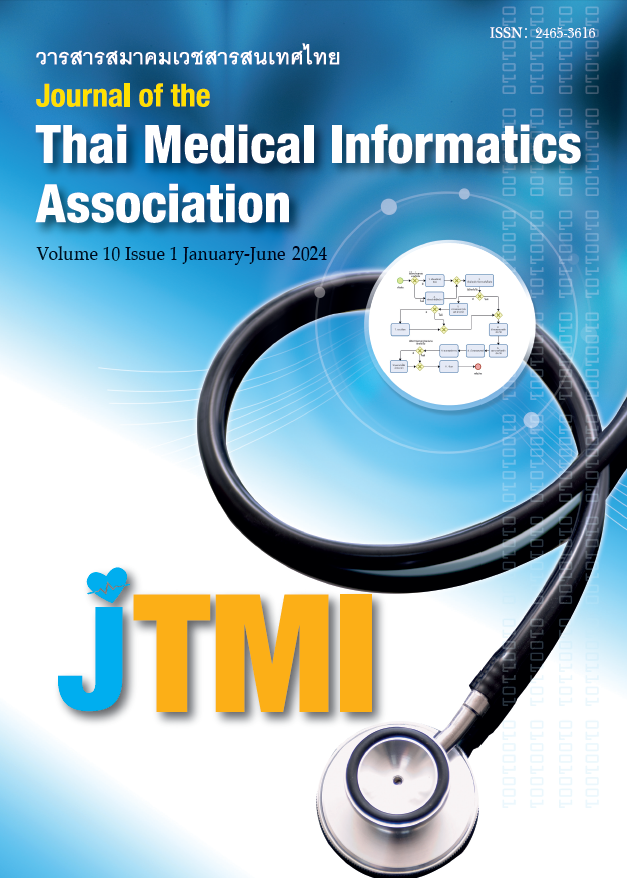Fast Track Alert System Timer (FAST): Reducing time to antibiotics for septic patients in the emergency department
Keywords:
Sepsis, Septic shock, Antibiotic, Time to antibiotic, Timer, Countdown, Mortality rateAbstract
INTRODUCTION – Timely antibiotic administration in sepsis patients is critical in reducing mortality. Many studies apply the alert system or timer to alert care team members to improve time in each care process. This study aims to evaluate the impact of the timer countdown on Time to antibiotic in septic patients.
METHODS – This study is a prospective cohort study, collecting data between April 2023 and September 2023 in the ED of a tertiary care hospital. By comparing the pre and post-implementation process (3 months each), the primary outcome is Time to antibiotic, and the secondary outcome is the Mortality rate.
RESULTS – Comparing the average Time to antibiotics, the pre-implementation process time is 54 minutes (SD=35.6), and the post-implementation process time is 34 minutes (SD=19.5) (p= 0.0315). The in-hospital mortality rate is significantly improved in the Post-implementation group compared to the Pre-implementation group, with average mortality rates of 29% and 45% (p= 0.029), respectively.
CONCLUSION – Fast track Alert System Timer can improve the Time to antibiotic in septic patients. This study outlines an easy-to-implement, low-cost solution for emergency departments looking to shorten the Time to antibiotic.
References
Singer M, Deutschman CS, Seymour CW, Shankar-Hari M, Annane D, Bauer M, et al. The Third International Consensus Definitions for Sepsis and Septic Shock (Sepsis-3). JAMA. 2016 Feb 23;315(8):801-10.
Champunot R, Kamsawang N, Tuandoung P, Tansuphas wasdikul S. Saving 500 Lives Campaign: another way to improve the mortality rate of patients with severe sepsis and septic shock. Crit Care. 2012;16 (Suppl 3):P105.
Angus DC, Barnato AE, Bell D, Bellomo R, Chong CR, Coats TJ, et al. A systematic review and me ta-analysis of early goal-directed therapy for septic shock: the ARISE, ProCESS and ProMISe Investigators. Intensive Care Med 2015;41:1549–1560.
Kalil AC, Johnson DW, Lisco SJ, Sun J. Early goal-directed therapy for sepsis: a novel solution for discordant survival outcomes in clinical trials. Crit Care Med 2017;45:607–614.
Im, Y., Kang, D., Ko, RE. et al. Time-to-antibiotics and clinical outcomes in patients with sepsis and septic shock: a prospective nationwide multicenter cohort study. Crit Care 26, 19 (2022). https://doi. org/10.1186/s13054-021-03883-0
Makam, A. N., Nguyen, O. K. & Auerbach, A. D. Diagnostic accuracy and effectiveness of automated electronic sepsis alert systems: a systematic review. J. Hosp. Med. 10, 396–402 (2015).
Jung, A. D. et al. Sooner is better: use of a real-time automated bedside dashboard improves sepsis care. J. Surg. Res. 231, 373–379 (2018).
Alberto, L., Marshall, A. P., Walker, R. & Aitken, L. M. Screening for sepsis in general hospitalized patients: a systematic review. J. Hosp. Infect. 96, 305–315 (2017).
Wulff, A., Montag, S., Marschollek, M. & Jack, T. Clinical decision-support systems for detection of systemic inflammatory response syndrome, sepsis, and septic shock in critically Ill patients: a systematic review. Methods Inf. Med. 58, e43–e57 (2019).
Joshi, M. et al. Digital alerting and outcomes in patients with sepsis: systematic review and metaanalysis. J. Med. Internet Res. 21, e15166 (2019).
p Hwang, M. I., Bond, W. F. & Powell, E. S. Sepsis alerts in emergency departments: a systematic review of accuracy and quality measure impact. West J. Emerg. Med. 21, 1201–1210 (2020).
สมาคมเวชบบัดวิกฤต. (2558). การดูแลรักษาผู้ป่วย Severe Sepsis และ Septic Shock (ฉบับร่าง) แนวทาง เวชปฏิบัติ. กรุงเทพฯ : สมาคมเวชบ าบัดวิกฤต.
Beale R, Reinhart K, Brunkhorst FM, et al. Promoting Global Research Excellence in Severe Sepsis (PROG RESS): lessons from an international sepsis registry. Infection. 2009;37(3):222-32.
Marto JP, Borbinha C, Calado S, Viana-Baptista M. The Stroke Chronometer-A New Strategy to Reduce Door-to-Needle Time. J Stroke Cerebrovasc Dis. 2016 Sep;25(9):2305-7. doi: 10.1016/j.jstrokecere brovasdis.2016.05.023. Epub 2016 Jun 23. PMID: 27345463.
Matsumoto S, Koyama H, Nakahara I, Ishii A, Hatano T, Ohta T, Tanaka K, Ando M, Chihara H, Takita W, Tokunaga K, Hashikawa T, Funakoshi Y, Kamata T, Higashi E, Watanabe S, Kondo D, Tsujimoto A, Furuta K, Ishihara T, Hashimoto T, Koge J, Sonoda K, Torii T, Nakagaki H, Yamasaki R, Nagata I, Kira JI. A Visual Task Management Application for Acute Ischemic Stroke Care. Front Neurol. 2019 Oct 30;10:1118. doi: 10.3389/ fneur.2019.01118. PMID: 31736851; PMCID: PMC6831722.
Kamal N, Smith EE, Stephenson C, Choi PM, Goyal M, Hill MD, et al. Visualizing acute stroke data to improve clinical outcomes. Stroke. (2015) 46:e170–2. doi: 10.1161/STROKEAHA.115.009517
Lin CB, Cox M, Olson DM, Britz GW, Constable M, Fonarow GC, et al. Perception versus actual performance in timely tissue plasminogen activation administration in the management of acute ischemic stroke. J AmHeart Assoc. (2015) 4:e00129. doi: 10.1161/JAHA.114.001298
Seoane L, Winterbottom F, Nash T, Behrhorst J, Chacko E, Shum L, Pavlov A, Briski D, Thibeau S, Bergeron D, Rafael T, Sundell E. Using quality improvement principles to improve the care of patients with severe sepsis and septic shock. Ochsner J. 2013 Fall;13(3):359-66. PMID: 24052765; PMCID: PMC3776511.
Seymour CW, Gesten F, Prescott HC, Friedrich ME, Iwashyna TJ, Phillips GS, et al. Time to treatment and mortality during mandated emergency care for sepsis. N Engl J Med. 2017;376(23):2235–44.
Liu VX, Fielding-Singh V, Greene JD, Baker JM, Iwashyna TJ, Bhattacharya J, et al. The timing of early antibiotics and hospital mortality in sepsis. Am J Respir Crit Care Med. 2017;196(7):856–63.
Barie PS, Hydo LJ, Shou J, Larone DH, Eachempati SR. Influence of antibiotic therapy on mortality of critical surgical illness caused or complicated by infection. Surg Infect (Larchmt). 2005;6(1):41–54






